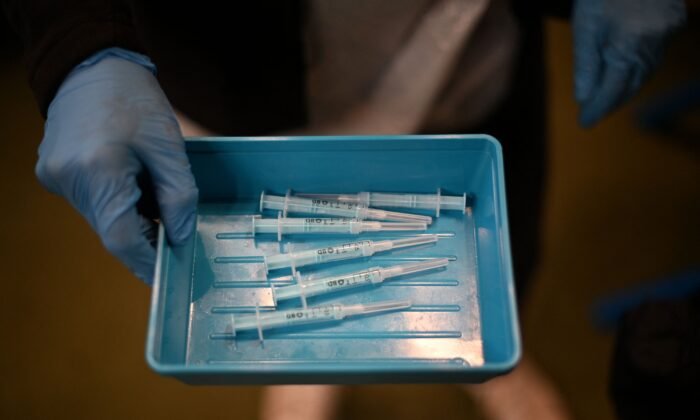What Factors Contributed to the Safety and Effectiveness of COVID-19 Vaccines?
With any new technology, there may be new risks, some of which might be ‘unknown unknowns.’
Commentary
The COVID-19 vaccines have been part of our lives for nearly three years, yet few people realise how different they are from vaccines we have used before.
During the first two years of the pandemic, I was a medical journalist writing for GPs and specialist doctors. I had not come across an mRNA vaccine and I had not heard of a DNA viral vector vaccine.
Nevertheless, like most of us, I was very relieved when the vaccines arrived in December 2020, because my dad was 87 and vulnerable.
Now, almost three years later, I think that the government should have been more transparent about the technology they were rolling out.
Some of us had Pfizer or Moderna injections, for instance, not knowing that a vaccine using mRNA (messenger ribonucleic acid) technology had never been approved for use in humans before COVID.
Related Stories
AstraZeneca (AZ) used a different technology, based on DNA (deoxyribonucleic acid). Only two similar vaccines for humans had been approved in the world prior to the AZ vaccine. These were in 2019 and 2020 for the rare and deadly disease, Ebola.
The three COVID injections differ from conventional vaccines because they use gene technology. A small piece of genetic code—in either mRNA or DNA form—is packaged and injected into our arms.
That genetic code tells our bodies to make the spike protein that protrudes from the virus particle. This protein is then recognised as foreign, and our bodies learn how to mount an immune response to it.
That should make us better prepared if we encounter a coronavirus bristling with spike proteins later in our lives.
So, why take this roundabout route of getting our bodies to make the spike protein instead of simply injecting a small amount of the protein as you might with a conventional vaccine? Pfizer-BioNTech COVID-19 vaccine vials are seen in a file photo. (cortex-film/Shutterstock)
It’s all about the ease and cost of vaccine production.
First, making DNA and mRNA is relatively easy and can be done quickly. It’s much simpler to do than making a conventional vaccine—that is normally done either by making an inactivated form of the virus or by isolating a protein from it.
Both viruses and proteins are delicate things that must be kept in a precise shape to be useful, so manipulating them to make a conventional vaccine can be tricky.
Unknown Unknowns?
It’s clear that genetic vaccines may be attractive to pharmaceutical companies because they provide a cheaper and more rapid route to market. And making vaccines to tackle new threats more quickly has obvious advantages for us all.
But, of course, we must be sure genetic vaccines are as safe and effective as conventional ones.
With any new technology, there may be new risks, some of which might be “unknown unknowns.”
The biochemistry of the human body is complicated, and a wise medical researcher expects surprises.
What’s more, people differ, so a drug or vaccine that has no side effects for most people may seriously harm a few. This is the reason safety trials include large numbers of participants.
Science is all about asking questions and then doing experiments to answer them. Here are just five of many questions about the genetic vaccines now being raised by people around the world.
First, how much spike protein do people make after a shot? And do different people make different amounts?
Second, how long is the DNA or mRNA active in our bodies? One thing we do know is that both Pfizer and Moderna use a synthetic mRNA that contains N1-methylpseudouridine. This makes the synthetic version last longer than normal mRNA.
Third, it would be nice to be sure that the genetic vaccine stays in the arm muscle and doesn’t reach other parts of the body. There could, for instance, be some organs in the body where making spike proteins would not be a good idea.
Fourth, could this new type of vaccine be harmful in ways that a normal vaccine would not be?
And fifth, when they were rolled out, did we have evidence that the vaccines stopped people from transmitting the virus to others? This is important because we were encouraged to get the injections so that we wouldn’t put other (vulnerable) people at risk.
Is the Devil in the Details?
To try to answer these questions I turned to the public assessment reports (PARs)—a weighty 352 pages in all!
These reports are produced by the UK’s Medical and Healthcare Products Regulatory Agency (MHRA) when it approves a drug or vaccine, and they give the evidence behind the approval decision (the PAR for the Moderna vaccine was produced by the European Medicines Agency).
All three PARs are publicly available on the UK government’s website.
None of the PARs show how much spike protein is made in a person’s body or how long the DNA/mRNA remains active, so, unfortunately, we draw a blank in answering questions one and two.
The PARs did provide some information from animal “biodistribution” studies that suggest the vaccines may not just stay in the arm muscle.
We are told, for instance, that “low levels” of DNA from the AZ vaccine “were detectable in bone marrow, liver, lung and spleen” of laboratory mice (pdf). A lab mouse. (Oleg Senkov/Shutterstock)
For Moderna (pdf), no biodistribution studies were reported with the COVID vaccine itself, but a study of a similar vaccine was reported.
This showed that in rats, “low levels of mRNA could be detected in all examined tissues except the kidney.” We are told this included the liver, heart, lungs, testes, and brain and that higher levels were seen in the spleen and eye. We don’t know about ovaries because no female rats were tested.
A mouse study for the Pfizer vaccine suggested it reached the liver (pdf). We are told that information on “potential distribution” to other sites had been submitted to the MHRA, but it was not reported.
On the fourth question, whether the vaccines could do harm, we must remember that safety monitoring of people who were injected in the trials was carried out for just two months after the second dose. No long-term safety data was available.
No animal studies were done to see whether the mRNA/DNA in the vaccines could damage our genes (genotoxicity), according to the Pfizer and AZ documents.
For Moderna, a standard genotoxicity test of a similar mRNA vaccine in rats was done that showed raised levels of micronucleated red blood cells. This can be a signal of genotoxicity,but it can also be caused by other things. It was mentioned that genotoxicity data had been submitted for the COVID vaccine itself, but that did not seem to be reported.
Meanwhile, none of the genetic vaccines were tested to see whether they might increase the risk of cancer (carcinogenicity).
Indeed, for our latest approved “Autumn booster” vaccine, the Moderna bivalent Spikevax, the information leaflet for healthcare professionals (pdf) says “Carcinogenicity studies were not performed.”
By the way, the regulators mentioned a “theoretical risk” of Vaccine Associated Enhanced Disease (VAED) for all three vaccines. In other words, the MHRA and EMA were alert to the possibility that vaccination might make people get COVID more severely.
There was no evidence from the trials that this was occurring, but all three PARs say that the vaccine makers were instructed to keep monitoring for VAED.
So much for safety.
Effective at What?
Moving on to efficacy.
It’s important to be clear about what the word “effective” meant when the vaccines were rolled out.
Strictly, a vaccine can only be described as effective if it works in a real-world situation.
The original trial data could not show that the vaccines would be “effective” at promoting immunity in people such as the very sick and frail, people with immunodeficiencies, pregnant women, and young children, because people like this were not included.
Furthermore, the trials told us only that the vaccine was effective for two months against the strains of the virus that people encountered during 2020 (the year in which the trials were done). Anything else was a hope.
So when the government said they were effective, what exactly were the vaccines effective at doing? Stopping transmission of the virus; preventing people from getting COVID; or preventing severe disease and death? A largely empty St Pancras train station is seen in London, on Dec. 20, 2020. (Peter Summers/Getty Images)
Here’s what the trials showed.
If we amalgamate the data across the three vaccines, nearly 41,000 people in total were given two doses of a vaccine, while the…




